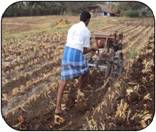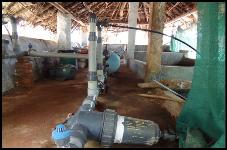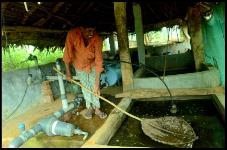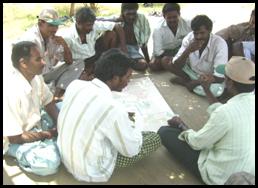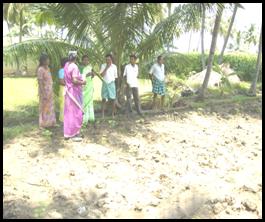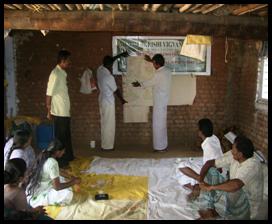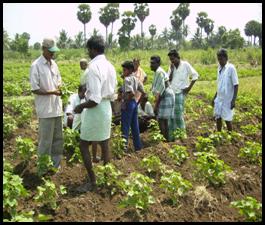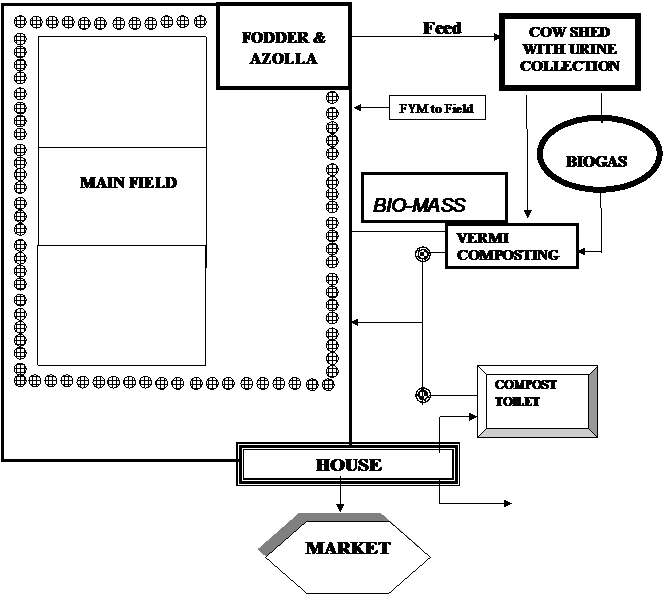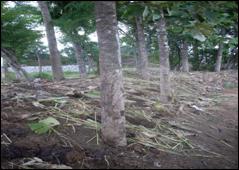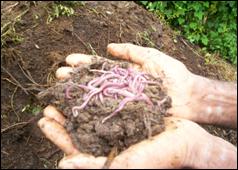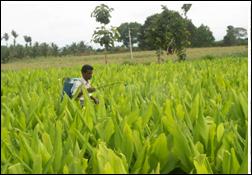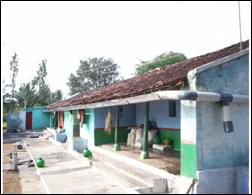 |
||||||||||||||||||||||||||||||||||||||||||||||||||||||||||||||||||||||||||||||||||||||||||||||
| Home | About Us | Success Stories | Farmers Association | Farmers' Innovation | Publications | FAQs | Contact | ||||||||||||||||||||||||||||||||||||||||||||||||||||||||||||||||||||||||||||||||||||||||||||||
Krishi Vigyan Kendra (KVK) :: Myrada Krishi Vigyan Kendra (MYRADA KVK), Erode District Recent Success Story: TURMERIC HARVESTER – An Innovative Farmer’s Pride Background: Mr. P. Ramaraj is practicing farming since 1980. He is cultivating crops like Turmeric, Vegetable, Banana and Sugarcane. Turmeric is one of the major crops in his field. This crop is annual and remunerative but highly labour oriented crop. 300 (112 male and 190 female) labours are require for an acre of cultivation of turmeric crops including sowing, weeding, earthing up, fertilizer and pesticide application, watering and harvesting, boiling, drying and polishing. Due to recently emerged labour scarcity in agriculture activities, farming work could not be carried out in time especially during harvesting season. If it is not harvested in time, crops can be damaged by the fungal diseases. It results in yield loss. He has faced this situation many times and incurred heavy yield loss. Therefore to manage this situation, he conceived alternative solution in harvesting of Turmeric crop. Thereby, he developed equipment named ‘Turmeric harvester’ in March 2010 after three years of his continuous efforts in developing the same. The cost incurred in developing the equipment accounts to Rs.20,000.00.
The harvester can be easily operated with the support of power tiller. Though it is small, adaptability and transportation of the machine is easy. During machine operation, less consumption of fuel is observed. By using the harvester for harvesting turmeric rhizome, there is chance to reduce the female labour for harvesting. By using the harvester, around Rs.7500.00 per acre can be saved in terms of labour. The Benefit cost ratio worked out comes to1:3.
Recognition:
Contact Address: Shri P. Ramaraj, Recent Success Story: Mechanization in Managing Cattle Resources Background: Mechanization in managing cattle resources (Dung + Urine) and reduce input cost in sugarcane cultivation developed by Mr. G.R. Sakthivel of Erode District. The filtering system consists of four compartments. The first section is meant for collection of cow dung and urine mixing. After through mixing the solution is being sent to second compartment for first filtration. In this compartment the solid matter is used for biogas production and the upper part solution is then allowed for next compartment where jaggery is added for fermentation. In the fourth compartment the clear enriched filtrated medium is collected and used for field though drip system
Practical utility of innovation: By adopting this technology the farmer can save Rs.27, 000/acre by reduction of labour and fertilizers through application of recycled cow dung and urine solution by filtration techniques. Field application with drip irrigation instead of manual operation also adds advantage to the innovation. By adoption of this technology water holding capacity is increased, the earth worm multiplied well in the field. This crop would be allowed as ratoon for longer time, by the way it reduces the cultivation cost for subsequent years
Recognition
Contact Address: Shri G.R.Sakthivel, Cotton Farmers Field School (FFS) 2008 –A Farmers Participatory extension strategy for dissemination of cotton technology in Erode district Background: To inculcate cotton technology to the farmers, Farmers Field School approach has been adopted at four villages namely Erangattuthottam, Pudupalayam, Thaneerpandal and Chellampalayam of Anthiyur block of Erode district. Surabi and MCU-5 are the ruling varieties of this region. The cost of cultivation is high due to excessive use of pesticides and unavailability of agricultural labours, which are the major issues faced by the cotton farmers in this area. Though a wholistic approach in cotton cultivation was being imparted, IPM technologies were emphasized as Pests and Diseases are the major cause for the indiscriminate use of pesticides. 100 farmers from four different villages were identified and four collaborators were selected from four respective villages. The short studies and long term experiments proposed were carried out in their field (Collaborator field). Interventions: Capacity building and demonstrations in all aspects of cotton cultivation viz., suitable varieties for the region, utility of cotton farm implements (Rotovator, power weeder), land preparation and seed treatment, proper spacing, mulching, skip furrow irrigation ,thinning (1-2 seedling/hole), scattered sowing of maize, fermented castor trap solution, Trichogramma chilonisegg card release, micronutrient spray(for Cotton reddening), plant growth regulator spray (for Square dropping) and NPV application method were imparted to the FFS farmers. The CMRC (Community managed resource centre), a federation of SHGs and farmers group managed by the KVK was highly helpful in locating the active cotton growers of the district and also in organizing and conduct the Farmers Field School. 20 weekly sessions were held in which AESA (Agro ecosystem analysis) a regular feature was carried out every week in the field with the participation of FFS farmers to analyze the abiotic and biotic stress on the plant. The observations (Biometric and Fauna population) recorded in the field (Sub group) were pooled and the subsequent operations and conclusions were arrived by the farmers themselves.
Farmers Experience: Duraisamy from Erangattuthottam village opined that before attending the Farmers field school, he was not able to identify the insects in the field. Through Farmers field school, he came to know about the cotton pests and their natural enemies and their differentiation. Before attending the Farmers field school, he used to go for 6-7 chemical sprays in the field. But this time, he had sprayed only once. The cotton plants beard more squares and bolls. Through Farmers Field School; he said that he has developed the ability to take crop management decision by his own. Padmavathi from Adireddiyur village said that all these days, whenever the farmer come across any insect or disease problem in cotton, he/she fetches chemicals from shop and sprays in his/her field. After the intervention of MYRADA-KVK through Front line demonstration and FFS in cotton, they don’t buy chemicals from shop instead, prepare organic amendments like panchakavya, Jeevamirtham, vermicompost and botanical pest repellant at their own farm and use them. By using these organic amendments, the cotton plants looked healthy with decreased incidence of insects and diseases. Padmavathi said that she got a yield of 12 quintals of cotton seed lint from an acre of land this particular year. Seethalakshmi from Adireddiyur village expressed that earlier she used to apply inorganic fertilizers like urea, potash and DAP to the cotton field. But after the cotton soil being tested and through the capacity building programmes (through FFS), inorganic fertilizers like urea, potash were decreased and usage of organic amendments like farm yard manure, neem cake were used by which the plant looked healthy with optimum yield (8 q/ha). Kumar from Adireddiyur village is a regular participant of Farmers field school. He said that apart from agricultural activities, the exposure being given on allied activities like mushroom cultivation, azolla cultivation and vermicompost production was very much helpful in enabling him to take up a self employment activity. He reported that he is earning RS.1000 every month by selling vermin compost.
Case study on Integrated Farm Development Background:
Integrated Farm Development is an innovative concept in farming wherein integration of various resources (farm waste) is utilized in order to reap maximum benefits out of them. The transition strategy or technique from inorganic agriculture to organic agriculture is being adopted in this approach. Success Story of Mr. Nagesh: Mr.Nagesh is one among the best practitioners and having the real thirst of disseminating the concept of IFD among other farmers. Mr. Nagesh and family living in M. P. Doddi village of Talavadi block, is a member of Basweswara sangha. He has adopted the technology in 2001 with the technical intervention of MKVK. He had been exposed to various fields of progressive farmers in the district and capacity building program which were being given to him as critical inputs of MKVK. This Case study has the experience of this young and energetic farmer. Intervention Process of Integrated Farm Development
Biogas:
Vermicompost:
Cowshed with urine collecting pit Mr. Nagesh says after constructing the cattle shed that daily 20 kg of cow dung and 10-15 liters of urine are harvested effectively. This helped him to produce/replace
Another farmer, Rani (wife of Mr. Nandesh) said that now their cows look healthy and free from diseases. Earlier they used to spend on an average Rs.500/month for medical treatment of the animals but now there is no such expense for medication. Panchagavya:
Rain water harvesting: The simple man Mr. Nagesh says that he prefers to drink this rain water, which pure and uncontaminated and dependency on public water has reduced by this storage system. Other than that they use this water for cattle feeding, cooking, washing and other household purposes. When the counterperson asked about the contamination Mr. Nagesh said that the water tank is with airtight lid which avoids or protects water from sunlight exposure, which prevents microbes and other aquatics from growing inside the tank. In this way he has reduced the maintenance labor. It was MYRADA KVK’s interventions and guidance which lead us to carry out these components with confidence.
“I am not ready to waste even single unit of natural of resources, Eco san is an alternative approach to safe and efficient management of human excreta and urine. Ecological sanitation recycles human excreta safely and productively to improve soils. It minimizes water consumption in sanitation. It protects water resources and the environment from sewage pollution thereby offering very comprehensive public health protection. The effective utilization of Eco-san toilet wastes can be used as manure in agriculture field, in this way Mr. Nagesh used that decomposed manure into the fodder fields. IFD component wise classification in KVK operational area
|
||||||||||||||||||||||||||||||||||||||||||||||||||||||||||||||||||||||||||||||||||||||||||||||
Home | About Us | Success Stories | Farmers Association | Publications | FAQs | Site Map | Disclaimer | Contact Us |
||||||||||||||||||||||||||||||||||||||||||||||||||||||||||||||||||||||||||||||||||||||||||||||
